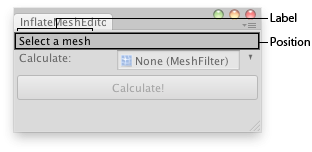EditorGUI.PrefixLabel
Parameters
| totalPosition | Rectangle on the screen to use in total for both the label and the control. |
| id | The unique ID of the control. If none specified, the ID of the following control is used. |
| label | Label to show in front of the control. |
Returns
Rect Rectangle on the screen to use just for the control itself.
Description
Make a label in front of some control.

Prefix Label in an Editor Window.
// Inflates a mesh // // Usage: Select a mesh and drag it to the object field. // Press calculate and after finishing just press play and see your mesh growing. // // Note: To control the ratio of inflation just change the increaseRatio // var in the "InflateMesh.js" sript class InflateMeshEditor extends EditorWindow { var object : MeshFilter; @MenuItem("Examples/Inflate Mesh") static function Init () { var window = GetWindow (InflateMeshEditor); window.Show (); } function OnGUI () { var rect = EditorGUILayout.GetControlRect (); rect = EditorGUI.PrefixLabel (rect, GUIContent ("Select a mesh")); object = EditorGUI.ObjectField (rect, "Calculate:", object, MeshFilter); EditorGUI.BeginDisabledGroup (!object); if(GUI.Button (EditorGUILayout.GetControlRect (), "Calculate!")) Calculate (); EditorGUI.EndDisabledGroup (); } function Calculate () { var finalNormals = new Vector3[0]; var mesh = object.sharedMesh; var vertices = mesh.vertices; var normals = mesh.normals; // Find identical vertices // this will hold an ID for each vertex, vertices at // the same position will share the same ID! var vertexIDs = new int[vertices.length]; var counter : int = 0; for (var i = 0; i < vertices.length; i++) { for (var j = 0; j < vertices.length; j++) { if (vertexIDs[i] == 0) { counter++; vertexIDs[i] = counter; } if (i != j) if (vertices[i] == vertices[j] && vertices[i] != 0) vertexIDs[j] = vertexIDs[i]; } } finalNormals = normals; calculated = 0.5; // Calcualte average normals // counter is the highest vertexID, now go through all the groups and collect normal data for (var k = 1; k <= counter; k++) { var curAvgNormal : Vector3 = Vector3.zero; for (var l = 0; l < vertexIDs.length; l++) if (vertexIDs[l] == k) { // Add up all the normals of the vertices with identical positions curAvgNormal += normals[l]; } curAvgNormal.Normalize(); //Normalize the result for (var m = 0; m < vertexIDs.length; m++) if (vertexIDs[m] == k) finalNormals[m] = curAvgNormal; } object.gameObject.AddComponent ("InflateMesh").fNormals = finalNormals; Debug.Log ("Done Adding Component, press play and see your mesh being inflated!"); } }
And the script attached to the editor script:
// InflateMesh.js private var mesh : Mesh; private var vertices = new Vector3[0]; private var normals = new Vector3[0]; var fNormals = new Vector3[0]; var increaseRatio = 0.005; function Start () { mesh = GetComponent (MeshFilter).mesh; vertices = mesh.vertices; normals = mesh.normals; } function Update () { for (var i = 0; i < vertices.length; i++) { vertices[i] += fNormals[i] * Time.deltaTime * increaseRatio; } mesh.vertices = vertices; }